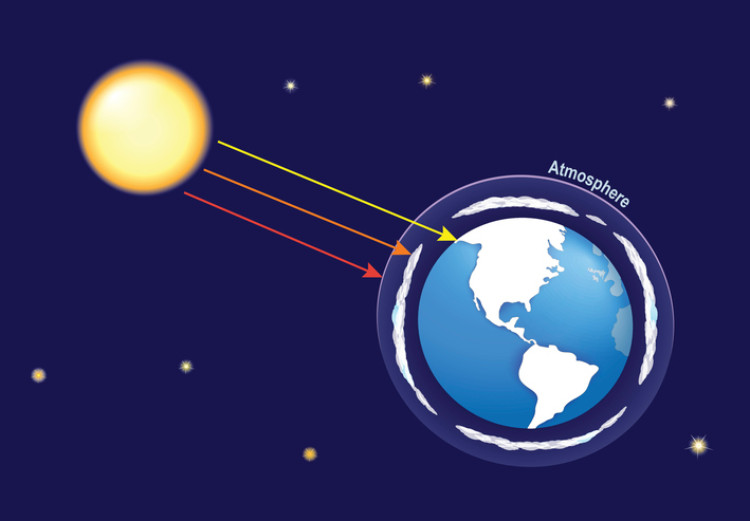Are you suffering from sun allergy? How does it manifest itself? Watch out for your skin and eyes

The Sun is the star to which we owe life as we know it, radiating the light and warmth we love so much. But despite the atmospheric barrier, dangerous UV radiation is also hitting the Earth, with harmful effects on the human body.
Article content
In addition to skin burning and sunburn, in some more sensitive individuals, the sun causes a more severe reaction - sun allergy - which has a more severe course than the common sunburn.
Read more about what sun allergy is and how it affects the body, skin or eyes.
What is UV radiation and how does it affect us?
The sun and solar radiation is the largest source of UV radiation (ultraviolet radiation), with only about 5-6% of the radiation reaching the Earth. Most of it is trapped in the atmosphere.
UV rays form part of the electromagnetic spectrum with wavelengths from 100 nm to 400 nm.
Artificial sources are found, for example, in the mountain sun, otherwise also used for medical purposes, in tanning lamps (fluorescent lamps) or germicidal emitters, which are mainly used in the health sector as a tool for killing bacteria.
Negative effects on the human body
- ultraviolet rays affect the cells of living organisms, including humans, by a number of mechanisms
- intracellularly affecting enzymes and deactivating them (making them inactive)
- their negative effects on proteins (denaturation of proteins) and nucleic acids
- they are responsible for slowing down cell division, i.e. cell growth, and are directly responsible for cell mutations and chromosomal aberrations
- causes changes in DNA by damaging bases and polynucleotide chains only up to a wavelength of 260 nm
- increases the number of mitoses, e.g. tumours and excess cells are gradually eliminated
- they also affect melanin (skin dye), causing hyperpigmentation (excessive skin colouring) but also hypopigmentation (disappearance of skin dye), leaving ugly brown or white spots on the skin
- high doses cause painful burning of the skin, depending on the intensity, duration and skin type
- phototoxic reactions - skin reactions caused by sun exposure and a combination of drugs or other irritants
- skin ageing or helioderma due to repeated and intense penetration of harmful radiation into the skin
- allergic reactions as described below in some more sensitive individuals
- skin cancer and its malignant spread if diagnosed late

Positive effect on the human body
- synthesis of vitamin D, which is essential (10 min of exposure to the sun)
- formation of red blood cells
- affects the hormone melatonin, which controls our biorhythm and influences our mental state
- it helps immunity and improves muscle performance, but when overexposed it does exactly the opposite
- has been reported to have a positive effect on some skin diseases, such as psoriasis
The basic breakdown of UV radiation
- UVA radiation accounts for up to 95% of the total radiation reaching the Earth. It occurs irrespective of the season and weather. It even reaches through clouds. It penetrates the surface layer of the skin (epidermis) and reaches the dermis. It does not feel hot, so its effect is not felt as heat. It is dangerous because it produces free radicals that destroy the elastin and collagen fibres of the skin. This causes it to lose its strength, dry it out and cause ageing. It causes allergic reactions, pigment spots, skin cancer and compromises the immune system
- UVB radiation makes up the remaining 5% of the radiation that penetrates the atmosphere. It is strongest in the summer months. It is stopped by clouds, but also by glass. It penetrates only the surface layer of the skin (epidermis) and does not reach the deeper layers. In summer, it is responsible for a nice, bronze tan, but also for sunburn, redness, sunburn, sun allergies and skin tumours. This radiation is also responsible for so-called snow blindness.
- UVC radiation is the most dangerous. It has cancer-causing effects and can cause severe burns up to third-degree blistering. However, it is completely absorbed by the atmosphere. For this reason, it does not have a significant effect on humans. However, by destroying the ozone layer in the long term, it is more than likely that it will be talked about more often.

Sun allergy and its clinical picture by type of allergy
It is an undesirable, local, skin reaction at the site exposed to sunlight, and in some specific cases outside the area exposed to sunlight. Ultimately, it affects the skin - the largest organ of the human body, accounting for up to 16% of the body's weight.
The skin becomes uncomfortably itchy, swollen, reddened locally with small hives (urticaria), as in most allergic reactions, and may develop large whitish or yellowish blisters, which burst, with subsequent scarring or pigmentation.
It also has a negative impact on the eyes, causing progressive damage to vision.
There are several types of sun allergy. They differ symptomatologically.
Polymorphic light eruption
Polymorphosus light eruption (PLE) is the most common type of sun allergy. It is caused in 80% by UVA radiation, i.e. it penetrates the deeper layers of the skin.
It occurs in people with compromised cellular defences, whose cells are attacked by reactive free radical chemical compounds with a subsequent exaggerated immune response.
It is more common in fair-skinned people and in women in a ratio of 4:1. It occurs mostly after the first prolonged exposure to the sun, on areas not protected by clothing (face, neck, shoulders, hands).
It manifests itself in various ways - from itching, redness of the skin, especially on the inner sides of the shoulders, to local swelling. In more severe forms, small rashes to painful blisters form.
An increased number of people suffering from this type of allergy is in spring and summer.
Actinic prurigo
This is a form of PLE. It has been shown to be familial in occurrence. Like PLE, it occurs predominantly in girls in spring and summer. Children up to puberty are affected by this form.
It rarely persists into adulthood.
It affects parts that have not been exposed to the sun, mainly the face, cheeks, lips, ears, shoulders and hands. Primarily, bumps appear on the skin, which bother the sufferer with excessive itching.
They are filled with fluid and may develop unsightly scars when they rupture.
Solar urticaria
Solar or sun urticaria is a very rare form of allergy. It arises after a relatively short period of exposure to the sun, and resolution occurs within a few hours. It affects mostly adults and older people, even on areas that have been protected.
It is typically manifested by reddening of the skin with urticaria or rare blisters.
Chronic actinic dermatitis
The name implies that it has a chronic course. Unlike other forms, it resembles eczema rather than allergy. It initially arises on areas exposed to sunlight and gradually spreads to areas that have been covered by clothing.
It manifests itself in patches of skin that are dry, inflamed and itchy. They are very extensive and there are parts of the affected skin that are not affected. It can also affect the hair on the head, palms and soles of the feet, which is not typical of other types of sun allergy.
Juvenile actinic dermatitis
Juvenile (childhood) actinic dermatitis occurs at a young age, most commonly from the age of 5 to about 15 years. Its manifestations are mainly observed in spring or early summer.
Children develop small blisters filled with clear fluid on the earlobes (external ear canal) after the first exposure to sunlight, with spontaneous resolution of the symptoms within a few weeks, usually sooner.
What prevention and treatment is appropriate?
Photodermatoses, as the name suggests, are caused by exposure to sunlight. Specifically, it is UVA and UVB radiation that penetrates through the atmosphere and affects the skin and eyes.
The cause is obvious. Protection should be aimed at eliminating (destroying) the triggering factor and treatment should be symptomatic (relieving symptoms) and anti-allergic (counteracting the allergy in general).

10 tips on how best to protect yourself from UV radiation
1. Limit prolonged exposure to direct sunlight, especially between the hours of 10:00-15:00.
Some people, especially women, take advantage of this to get a quick tan. However, there is a risk of maximum penetration of radiation into the skin with all its negatives.
The skin quickly burns, reddens and peels. This causes unsightly white islands with loss of pigment to appear on the body. These persist on the skin for a very long time.
Sometimes they are a problem even the following summer when we try to get a symmetrical tan and they keep appearing after the next sunbath.
2. Limiting sudden and intense tanning, especially at first contact after winter. Every woman wants to be beautifully tanned after winter, but none of us has the patience. We want white skin to turn bronze quickly, so with the first ray of sun we expose our body and put it in danger.
It must be remembered that in winter it was protected by clothing and such a sudden glare causes a shock to our body.
3. Avoiding or limiting exposure to the sun in case of other skin diseases and eczema. Skin diseases themselves cause us discomfort. Many of them such as psoriasis, eczema or atopic dermatitis make the skin dry, and it peels off. This condition is only multiplied by UV radiation and worsens the course of the underlying disease and thus further treatment.

4. Irradiation of the skin with a special UV lamp as an adaptation before sun exposure (phototherapy) prevents rapid sunburn by gradually exposing the skin to ultraviolet radiation in small doses.
5. Protecting the skin with clothing, head with a hat, eyes with UV filter goggles is the best protection to completely avoid the effect of radiation on the skin. A head covering also protects against heatstroke, avoiding the unpleasant condition of hyperthermia (increased body temperature due to heat) with intense headaches, weakness, dizziness and severe vomiting. This results in collapse conditions and difficult dehydration especially in children and the elderly.
6. Protect the skin with products with an SPF of at least 30 on the body and 50 on the face several times a day.
7. Protecting the skin with waterproof SPF products when in water is very important. Water transmits most of the rays. Therefore, do not fall into the false belief that you are protected in water.
8. Avoid substances that cause increased photosensitivity. These are mainly disinfectant solutions, perfumes, creams.
9. Avoiding drugs that cause photosensitivity. These include primarily antibiotics, some acne and pressure medications, and some pain relievers, especially non-steroidal anti-inflammatory drugs (ibalgin, brufen).
10. Caution: don't make the same mistake as others!
⇒ When overheating the body by sunbathing, it is necessary to cool it physically, with lukewarm showers and body wraps (wrap the chest and abdomen - the center, acral parts such as arms, legs, forehead do not expose to cold).
The mechanism of overheating of the organism is fundamentally different from high temperatures due to some disease (for example, angina).
What helps in the event of a sun allergy?
- skin care with suitable products after sunbathing - cooling creams (usually containing aloe), pure aloe vera, panthenol
- oral corticosteroids in small doses also serve as prevention and treatment, e.g. hydrocortisone vuab, prednisone
- oral antihistamines block the histamine produced in the skin during allergy, relieving both allergy and itching
- corticosteroid topical creams are used only when a skin allergy has developed and are subject to prescription. They should be applied in a thin layer only to the affected part of the skin.
Let's take a look at all the summer problems together:
Our health in summer - sun, heat, injuries, illnesses










